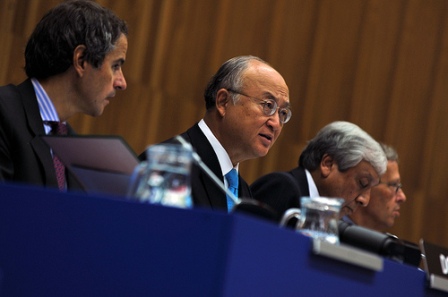Amano: New nuclear remains on the agenda
13 September 2011
The worldwide use of nuclear energy will continue to grow despite the Fukushima Daiichi accident, the director general of the International Atomic Energy Agency (IAEA), Yukiya Amano, told a meeting of its Board of Governors. Non-proliferation concerns remain in some countries, he noted.
 |
| Amano addresses the IAEA board (Image: IAEA) |
"We now expect the number of operating nuclear reactors in the world to increase by about 90 by 2030, in our low projection, or by around 350, in our high projection, compared to the current total of 432 reactors," Amano told the board. "This represents continuous and significant growth in the use of nuclear power, but at a slower growth rate than in our previous projections."
He noted that most of this growth will occur in countries already operating nuclear power plants, especially in Asia. "China and India will remain the main centres of expansion and their nuclear power capacities by 2030 are expected to be as projected before the accident, after a temporary period of slower growth," Amano said. "The projected slowdown in global growth reflects an accelerated phase-out of nuclear power in Germany, some immediate shutdowns and a government review of the planned expansion in Japan, and temporary delays in expansion in several other countries."
According to Amano, interest remains strong in countries considering introducing nuclear energy. He said that the factors that contributed to increasing interest in nuclear energy before the accident remain unchanged: "increasing global demand for energy, as well as concerns about climate change, dwindling reserves of oil and gas and uncertainty of supply of fossil fuels." However, he noted that "a few countries have cancelled or revised their plans, while others have taken a 'wait and see' approach."
Amano told the board that the situation at the Fukushima Daiichi site "remained very serious for many months," but the IAEA's assessment now is that the reactors are "essentially stable and the expectation is that the 'cold shutdown' of all the reactors will be achieved as planned."
Amano presented the IAEA board with a draft of a new Nuclear Safety Action Plan, the "result of an intensive process of consultations with member states." He told the meeting, "The draft Nuclear Safety Action Plan represents a significant step forward in strengthening nuclear safety. We must not lose our sense of urgency. I hope the draft action plan will be approved by the board and endorsed by the General Conference next week."
"In the aftermath of Fukushima Daiichi, the most important thing is to ensure transparency, build confidence, and meet the high expectations of the public. But it is actions, not words, that count. With this plan we will move from the planning phase to the implementation phase ... Further lessons will be learned and the plan will be updated accordingly."
"It will take rapid and visible improvements in nuclear safety - not just good intentions - to restore public confidence in nuclear power. The agency will play its central part with vigour."
Non-proliferation issues
Amano said that the IAEA has been continuing its work to set up a low-enriched uranium (LEU) bank and in May invited expressions of interest from member states willing to host such a bank. In July, Kazakhstan offered two sites for consideration, which an IAEA technical mission visited in August to review the offer. "We are discussing relevant technical matters with the government of Kazakhstan with a view to finalizing a decision on a site," he told the board.
The board was told that non-proliferation concerns still remained for North Korea, Iran and Syria.
The IAEA has not been able to implement any safeguards measures in North Korea since April 2009, "so our knowledge of the current status of the country's nuclear program is limited. That nuclear program is a matter of serious concern and reports about the construction of a new uranium enrichment facility and a light water reactor are deeply troubling."
Amano noted that during a visit by the deputy director general for safeguards to a number of Iran's facilities in August, "Iran demonstrated greater transparency than on previous occasions." However, he said that "greater transparency and Iran's full proactive engagement are also needed concerning its other nuclear activities."
The IAEA is "increasingly concerned about the possible existence in Iran of past and current undisclosed nuclear related activities involving military-related organizations, including activities related to the development of a nuclear payload for a missile, about which the agency continues to receive new information."
The IAEA continues to verify the non-diversion of nuclear material declared by Iran under its safeguards agreements, Amano said. However, "Iran is not providing the necessary cooperation to enable the agency to provide credible assurance about the absence of undeclared nuclear materials and activities in Iran, and therefore to conclude that all nuclear material in Iran is in peaceful activities." He called on Iran to "take steps towards full implementation of all relevant obligations in order to establish international confidence in the exclusively peaceful nature of its nuclear program."
The IAEA has previously concluded that "it is very likely" that the building destroyed at the Dair Alzour site in Syria was a nuclear reactor which should have been declared to the agency. In June, the IAEA board adopted a resolution finding Syria to be in non-compliance with its obligations under its safeguards agreement and reporting the matter to the UN Security Council. In a letter sent in August, Syria told the IAEA that it is ready to meet agency safeguards staff in October "to agree on an action plan to resolve the outstanding issues in regards to [the] Dair Alzour site."
Researched and written
by World Nuclear News